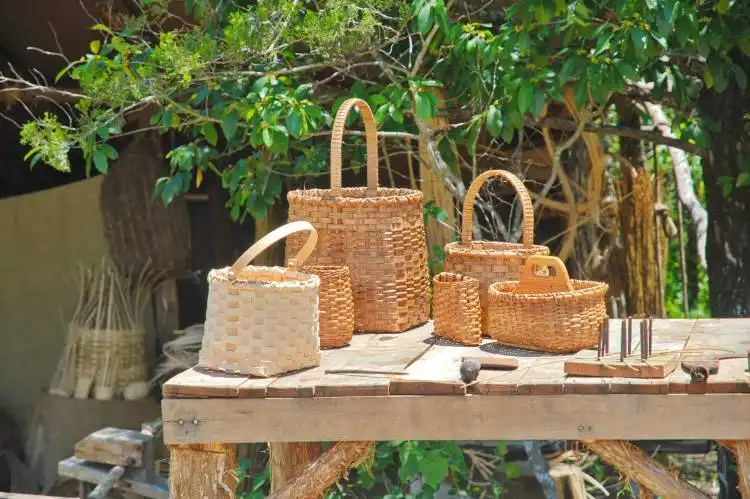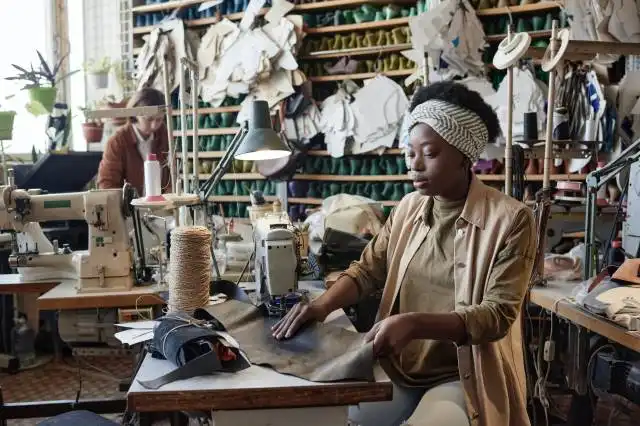Start a Longarm Quilting Business
Seamlessly Stitch your Passion into Profits: Starting your Dream Quilting Business
| Updated


LONGARM QUILTING BUSINESS
Dream of turning a crafting hobby into a livelihood? Consider a longarm quilting business, a dream enterprise for sewing enthusiasts. Essentially, this creative venture involves using longarm quilting machines to stitch together quilt tops, wadding, and backing into complete quilts. It's less about patchwork and more about compiling the patchwork into an awe-inspiring masterpiece! Plus, with your artistic touch and entrepreneurial spirit, you'll breathe new life into the age-old tradition of quilting, becoming the go-to professional for finishing off those handcrafted treasures.
Jump to Business Plan
RELATED BUSINESS IDEAS
Browse ALL Arts & Crafts Business Ideas
Discover Your Perfect Domain
Unlock the door to your online success with our hand-picked selection of premium domain names. Whether you're starting a new venture or rebranding an existing one, the right domain can set the tone for your digital presence. Browse through our curated list, each with its unique potential to enhance your brand's visibility and credibility.
LONGARM QUILTING MINI BUSINESS PLAN
This a quick reality check to help you identify the strengths and weaknesses of your business concept before you dive in.
Expected Percent Margin:
- Gross Margin: 60-70%
- Net Profit Margin: 15-25%
Earnings Expectations:
- Daily Earnings: $150 - $300
- Weekly Earnings: $750 - $1,500
- Monthly Earnings: $3,000 - $6,000
- Annual Earnings: $36,000 - $72,000
Actions to Hit Those Numbers:
Equipment:
- Longarm Quilting Machine: Initial investment can vary from $10,000 to $30,000.
Skill Development:
- Training: Extensive experience and skill is required. This can be gained through training classes, which often cost between $200 - $500.
Marketing and Customer Acquisition:
- Word of Mouth: This is crucial in a longarm quilting business. Encourage your customers to spread the word about your fantastic work.
- Quilt Shows: Attend and showcase your work at as many as possible to gain exposure.
Sales and Customer Experience:
- Customer Service: Make sure you are responsive and accommodating, as this can lead to repeat customers and referrals.
- Custom Orders: Offer the ability to fulfill custom orders as this can command higher prices.
Cost Control:
- Supplies: Make sure to buy your thread, batting, and backing fabric wholesale to save on costs.
- Utilities: Since your equipment can use a lot of electricity, try to make your work environment as energy efficient as possible.
Business Operations:
- Work Hours: The business can be run part-time or full-time depending on your preference and how quickly you can quilt.
- Pricing: Be sure to charge for your time and expertise, not just the materials. A typical price is around 2 cents per square inch for a simple pantograph design.
These are rough estimates and can greatly vary depending on a variety of factors. Please consult with a financial advisor for specialized advice.
NOT WHAT YOU HAD IN MIND? Here are more ideas



Browse ALL Arts & Crafts Business Ideas
Grab Your Business Website Name
Before you get caught up in the whirlwind of setting up your business, invest in a domain name. It's a small but significant step that lays the foundation for your brand and makes it easier for customers to find and trust you. Just like you wouldn't build a house without securing the land first, don't build a business without securing your domain name.
"Why? Can't that wait?" Here's why it shouldn't
Step 1: Determine if a Longarm Quilting Business is Right for You
Breakdown of Startup Expenses
Before starting a longarm quilting business, it is important to understand the startup costs associated with the venture. These costs can include the cost of the longarm quilting machine, fabric, thread, batting, and any other supplies necessary to complete the quilting process. Additionally, there may be costs associated with marketing, advertising, and website development. It is important to research the costs of these items and add them up to get an accurate estimate of the total startup costs.
Breakdown of Ongoing Expenses
In addition to the startup costs, it is important to consider the ongoing costs associated with running a longarm quilting business. These costs can include the cost of electricity, rent, insurance, and any other costs associated with running a business. Additionally, it is important to consider the cost of any additional supplies that may be necessary to complete quilting projects. It is important to research the costs of these items and add them up to get an accurate estimate of the total ongoing costs.
Examples of Ways to Make Money
Once the startup and ongoing costs of running a longarm quilting business have been determined, it is important to consider potential sources of income. One way to make money is to offer quilting services to customers. This could include taking on custom quilting projects or offering quilting classes. Additionally, it is possible to make money by selling quilting supplies or finished quilts. It is important to research the potential sources of income and determine which ones are the most viable for the business.
Step 2: Name the Business
When naming a longarm quilting business, it is important to choose a name that is memorable, unique, and reflects the services offered. It is also important to make sure the name is not already in use by another business. Consider using a combination of words that are related to quilting, such as “stitch”, “quilt”, “sew”, “fabric”, or “thread”. It is also helpful to use a name that is easy to pronounce and spell. Additionally, consider using a name that is associated with the area in which the business is located. This can help customers find the business more easily.
When deciding on a name, it is important to check with the local government to make sure the name is available and not already in use. Additionally, it is important to check the internet to make sure the name is not already in use by another business. It is also important to check the United States Patent and Trademark Office website to make sure the name is not already trademarked. Once the name is chosen, it is important to register the business name with the local government. This will help protect the business name and ensure that it is not used by another business.
Once the name is chosen, it is important to create a logo and slogan for the business. The logo should be simple, memorable, and reflect the services offered. Additionally, the slogan should be catchy and reflect the services offered by the business. The logo and slogan should be used on all marketing materials, including business cards, websites, and social media accounts.
Finally, it is important to create a website for the business. This will help potential customers find the business and learn more about the services offered. The website should include information about the services offered, pricing, contact information, and a portfolio of past work. Additionally, the website should be optimized for search engines to help potential customers find the business more easily.
Step 3: Create a Business Plan
Creating a business plan is a critical step in starting a longarm quilting business. The business plan should include a detailed description of the business, a market analysis, a competitive analysis, a financial plan, and a management plan. When creating the business plan, it is important to include a detailed description of the business, including the services offered, the target market, and the pricing structure. Additionally, the business plan should include a market analysis, which should include an analysis of the current market, potential customers, and potential competitors. The competitive analysis should include an analysis of the current competitors, their strengths and weaknesses, and how the business will differentiate itself from the competition. The financial plan should include a breakdown of startup expenses, ongoing expenses, and potential sources of revenue. Finally, the management plan should include a description of the management team, their roles and responsibilities, and their qualifications.
Step 4: Obtain Licenses and Permits
Before starting a longarm quilting business, it is important to obtain the proper licenses and permits. Depending on the state, this may include a business license, a sales tax permit, and a zoning permit. It is important to research the specific requirements for the state in which the business will be located. It is also important to check with the local county or city government to determine if any additional permits are needed.
Business Insurance
In addition to the necessary licenses and permits, it is important to obtain business insurance. This will protect the business from potential liabilities and losses. Business insurance can cover a variety of things, such as property damage, personal injury, and legal costs. It is important to research the different types of insurance available and determine which type is best for the business.
Financing Options
Once the necessary licenses and permits have been obtained, it is important to consider financing options. This may include taking out a loan, using personal savings, or seeking out investors. It is important to research the different financing options available and determine which one is best for the business.
Professional Assistance
Finally, it is important to seek out professional assistance when starting a longarm quilting business. This may include hiring an accountant to help with taxes, a lawyer to help with legal matters, or a business consultant to help with the overall business plan. Professional assistance can help ensure that the business is properly set up and running smoothly.
Step 5: Find a Location
When choosing a location for a longarm quilting business, there are several factors to consider. First, the location should be easily accessible to customers. This could mean having a storefront in a busy shopping center or having a studio in a residential area. Second, the space should be large enough to accommodate the longarm quilting machine, fabric, and other supplies. Third, the space should be well-lit and have adequate ventilation. Finally, the location should be affordable. Renting a space in a shopping center or studio can be expensive, so it’s important to research the area and find a space that fits within the budget.
Register the Business
Once a location has been chosen, the business must be registered with the local government. This includes obtaining a business license, registering the business name, and obtaining any necessary permits. It’s important to research the local laws and regulations to ensure that the business is in compliance. Additionally, the business should be registered with the IRS and any other relevant government agencies. This will ensure that the business is properly taxed and that all necessary paperwork is filed.
Step 6: Purchase Equipment
Starting a longarm quilting business requires certain types of equipment. The most important piece of equipment is a longarm quilting machine. This machine is used to sew the quilt top, batting, and backing together. Other pieces of equipment needed include a frame to hold the quilt, a computerized quilting system, and a variety of quilting tools.
Where to Purchase Equipment
When purchasing equipment, it is important to research the different brands and models available. Many quilting stores offer longarm quilting machines, frames, and other supplies. Additionally, there are online retailers that specialize in quilting supplies. It is important to compare prices and read reviews before making a purchase.
Cost of Equipment
The cost of the equipment will vary depending on the type and quality of the machine and other supplies. A basic longarm quilting machine can cost anywhere from $2,000 to $10,000. The cost of the frame and other supplies will depend on the size and type of quilt being made. Additionally, there may be additional costs for software, thread, and other supplies.
Financing Options
For those who cannot afford to purchase the equipment outright, there are financing options available. Many quilting stores offer financing options with low interest rates. Additionally, there are online lenders that specialize in financing for small businesses. It is important to compare rates and terms before signing any financing agreement.
Step 7: Market the Business
Once the business is established, it is important to market the business to potential customers. One way to do this is to create a website or blog that showcases the quilting services offered. This website should include photos of quilts that have been made, pricing information, and contact information. Additionally, creating a presence on social media sites such as Facebook, Instagram, and Twitter can help to reach potential customers. It is also important to join local quilting groups and attend quilting events to network and advertise the business.
Examples of Advertising
Advertising is another important way to market the business. Advertising can include creating flyers and posters to distribute in the local community, placing ads in local newspapers and magazines, and creating radio and television commercials. Additionally, creating promotional materials such as t-shirts, mugs, and other items with the business logo can be a great way to get the word out about the business.
Utilizing Word of Mouth
Word of mouth is one of the most powerful forms of marketing and can be a great way to spread the word about the business. Encouraging customers to leave reviews on social media sites and to recommend the business to their friends and family can be a great way to get more customers. Additionally, offering discounts and referral programs can also help to spread the word about the business.
Creating a Brand
Creating a brand for the business is also important. This includes creating a logo and a tagline that will be used on all marketing materials. Additionally, creating a mission statement and a set of core values can help to define the business and make it stand out from the competition.
Step 8: Set Prices
When setting prices for your longarm quilting business, there are several factors to consider. First, you should consider the cost of materials and labor. This includes the cost of fabric, thread, batting, and other supplies. Additionally, you should factor in the cost of renting or purchasing a longarm quilting machine. You should also consider the cost of any additional equipment you may need, such as a computer, software, and other tools. Additionally, you should factor in the cost of any marketing materials you may need, such as business cards, flyers, and brochures. Finally, you should factor in the cost of your time and labor.
Setting Prices
Once you have determined the cost of materials and labor, you should set your prices accordingly. It is important to remember that you are running a business and that you need to make a profit. Therefore, you should set your prices high enough to cover your costs and make a profit. Additionally, you should consider the prices of your competitors and set your prices accordingly. You may also want to offer discounts for bulk orders or for repeat customers. Finally, you should be flexible with your prices and be willing to negotiate with customers.
Step 9: Prepare for Growth
Preparing for growth is an important step in starting a longarm quilting business. It is important to have a plan in place for when the business grows and how to manage the additional workload. To prepare for growth, it is important to have a plan for marketing, customer service, and financial management. This includes having a plan for how to handle additional orders, how to manage customer inquiries, and how to manage the finances of the business. Additionally, it is important to have a plan for how to handle additional employees, if necessary. It is also important to have a plan for how to expand the business, such as adding additional services or products.
Tips on Investing in Equipment
When preparing for growth, it is important to invest in quality equipment that will be able to handle the increased workload. Investing in high-quality equipment will help ensure that the business is able to handle the increased demand. Additionally, investing in quality equipment will help ensure that the business is able to produce quality products. It is important to research the different types of longarm quilting machines and find one that is best suited for the business. Additionally, it is important to invest in other necessary equipment, such as thread, batting, and fabric.
Tips on Investing in Training
When preparing for growth, it is important to invest in training for the employees. Investing in training will help ensure that the employees are able to handle the increased workload and produce quality products. Additionally, investing in training will help ensure that the employees are able to handle customer inquiries and provide excellent customer service. It is important to research different training programs and find one that is best suited for the business. Additionally, it is important to invest in additional training for the employees as the business grows.
Tips on Investing in Technology
When preparing for growth, it is important to invest in technology that will help streamline the business processes. Investing in technology will help ensure that the business is able to handle the increased workload and produce quality products. Additionally, investing in technology will help ensure that the business is able to manage customer inquiries and provide excellent customer service. It is important to research different types of technology and find one that is best suited for the business. Additionally, it is important to invest in additional technology as the business grows.
EXPLORE MORE CATEGORIES
Browse ALL Business Idea Categories
TAKE THE NEXT STEPS










